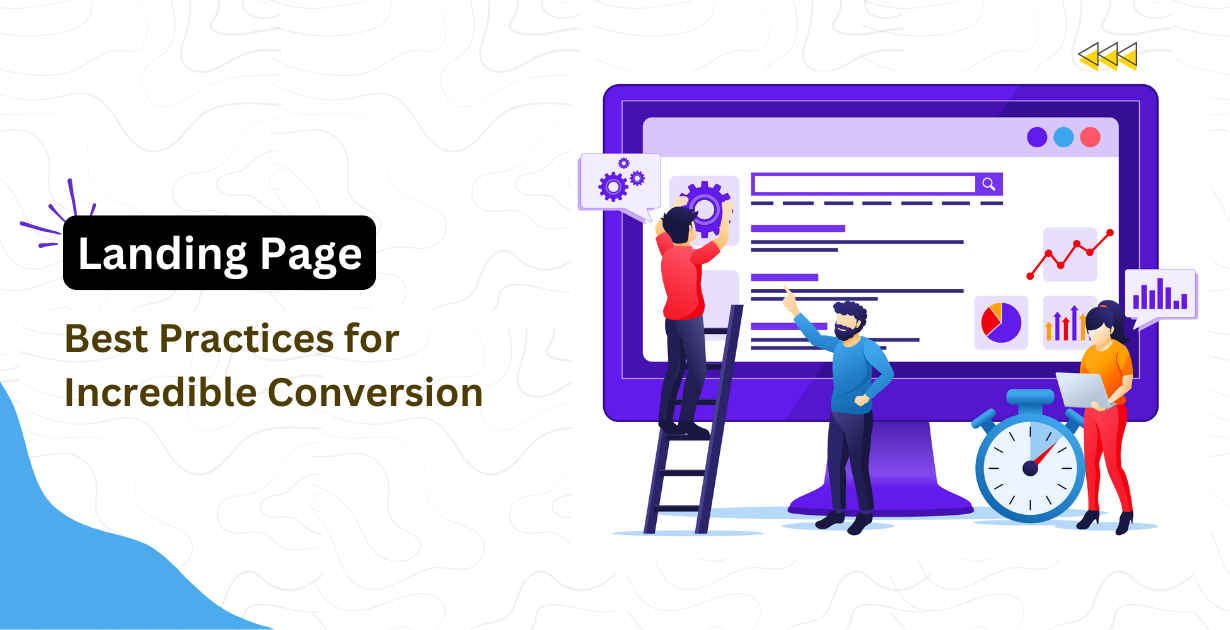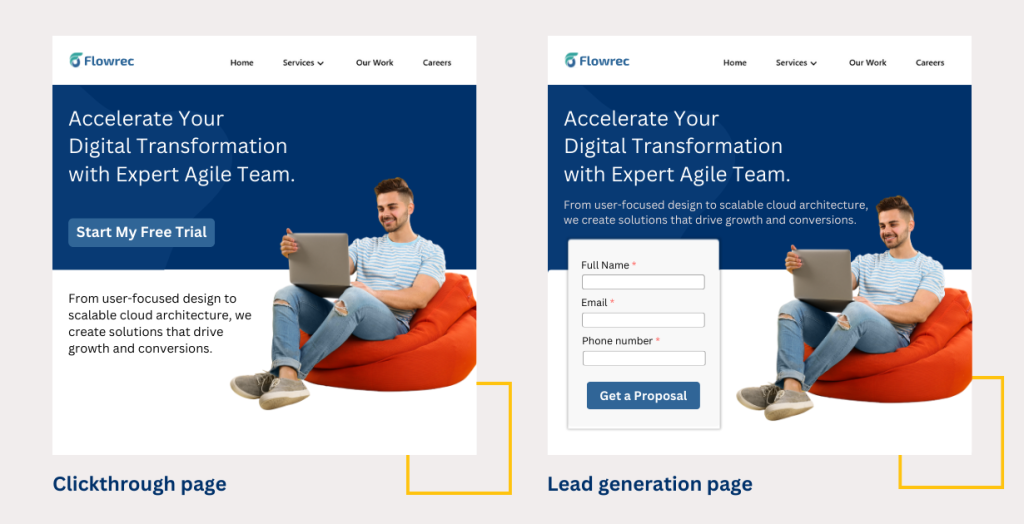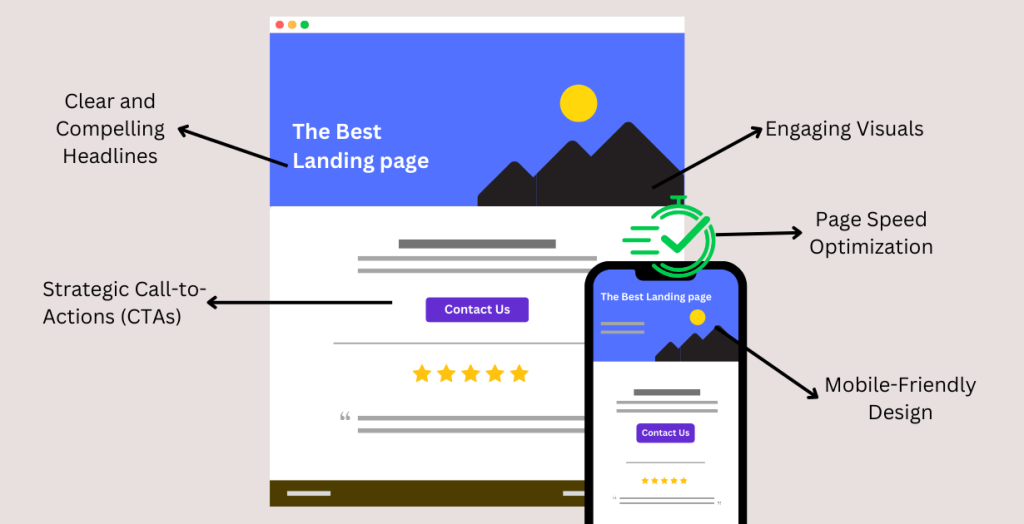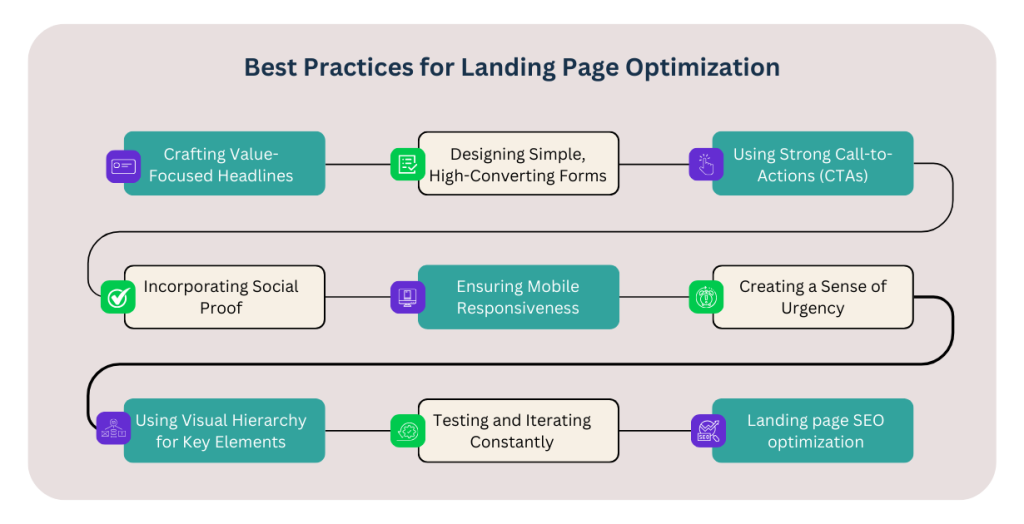
Landing pages are your business’s digital storefront, representing the first impression you leave on potential customers. They have the power to either hook a visitor instantly or lose them forever. Many businesses face challenges like low conversion rates, high bounce rates, or wasted marketing budgets due to poorly optimized landing pages. A cluttered design, weak call-to-action, or slow loading speed could be the reasons your visitors aren’t converting. Optimizing your landing pages is essential to not just attract visitors but also turn them into loyal customers.
This article dives deep into proven landing page optimization best practices to address these pain points. Whether you’re looking to improve lead generation, drive sales, or enhance user experience, you’ll find actionable insights here to transform your results.
Table of contents
- Landing Page Optimization: What & Why?
- When Should You Use a Landing Page?
- The Key Elements of an Optimized Landing Page
- Best Practices for Landing Page Optimization
- Tips to Adhere with while Optimizing Landing Page
- Build Your Landing Page Effectively with Flowrec
- Conclusion
Landing Page Optimization: What & Why?
Landing page optimization (LPO) is the process of improving the very first page someone sees on your website. It aims to make that page easy to understand, interesting, and clear, so visitors are more likely to do what you want them to do, like buy a product or sign up. It matters because a well-designed landing page can boost sales and build trust. By adjusting design and language, you can turn curious visitors into happy customers and grow your business.
Why Is Landing Page Optimization Crucial?
Landing pages are vital for businesses because they give a strong first impression to visitors. This is especially important for startups, which often have limited time and resources. By focusing on landing page optimization, they can quickly show their value, build trust, and increase sales or sign-ups. Here are the factors why your business may require a landing page for effective drive:
- Boosts Conversion Rates: Optimized landing pages directly address visitors’ pain points, providing them with clear and relevant solutions. This ensures they are more likely to take the desired action, whether it’s signing up or making a purchase.
- Improves Ad Spend Efficiency: A well-optimized landing page makes every click count. By aligning the page with ad intent, businesses reduce wasted clicks and ensure higher returns on investment from paid campaigns.
- Reduces Bounce Rates: When visitors quickly find the information they’re looking for, they are less likely to leave the page. Engaging content and user-friendly design help keep users on the page longer.
- Enhances User Trust: Clear messaging, social proof, such as testimonials and trust badges, reassures visitors about your business’s credibility, encouraging them to take the next step.
- Increases Sales Opportunities: By strategically guiding users toward specific actions, such as adding items to a cart or completing a form, landing pages effectively drive users down the sales funnel and convert interest into revenue.
Whether you work with a landing page optimization agency or go the DIY route, it’s essential to follow proven practices.
When Should You Use a Landing Page?
A landing page isn’t just another page on your website—it’s a powerful tool for achieving specific goals. Whether you want to boost sales, capture leads, or promote a service, understanding when to use a landing page can make all the difference. Here are situations where a landing page becomes indispensable for your business:

- Launching a New Product or Service
A landing page is essential when introducing a new product or service to the market. It allows you to focus on showcasing its features, benefits, and value without distractions. By crafting a targeted message, you can generate excitement and drive conversions.
Example: A tech startup launching a wearable device created a dedicated landing page with a video demo and pre-order options. The page boosted sales by 30% during the launch period.
- Running a Marketing Campaign
If you’re running PPC ads, social media promotions, or email campaigns, a landing page ensures continuity and relevance. It reinforces your campaign message and guides visitors to take immediate action.
Example: An e-commerce brand running a Google Ads campaign created a landing page that mirrored the ad copy and offered a limited-time discount, resulting in a 50% increase in conversions.
- Capturing Leads
Lead generation is one of the primary uses of a landing page. Whether you’re collecting emails for a newsletter or gathering information for sales outreach, a landing page simplifies the process.
Example: A SaaS company offered a free e-book in exchange for contact details through a lead capture landing page, growing their email list by 40% in just a month.
- Promoting Events or Webinars
For events like webinars, workshops, or conferences, a landing page can provide all the necessary details while encouraging registrations. Include essential information such as date, time, and a registration form.
Example: A nonprofit organization doubled webinar registrations with a simple landing page featuring a countdown timer and an easy-to-fill sign-up form.
- Driving App Downloads
When promoting a mobile app, a landing page can highlight key features, provide direct download links, and answer common questions. It’s an excellent way to convert interested users into app downloads.
Example: A fitness app used a clean and responsive landing page showcasing app benefits and customer reviews, increasing downloads by 60% within weeks.
- Offering Personalized Content
Personalized landing pages deliver tailored content based on user behavior, interests, or demographics. This approach can significantly improve engagement and conversions.
Example: An online retailer used personalized landing pages to recommend products based on browsing history, achieving a 25% increase in sales.
- Building Brand Trust
Landing pages are effective for About Us sections, testimonials, or success stories. These pages give visitors insight into your brand’s mission, values, and achievements, building credibility and trust.
Example: A small business used an About Us landing page with team photos and customer testimonials, leading to a 20% rise in inquiries.
By using landing pages in these scenarios, you can achieve focused results and maximize your return on investment. A well-timed and strategically designed landing page has the potential to drive meaningful outcomes for your business.
The Key Elements of an Optimized Landing Page
To achieve the best results, every element on your landing page needs to work together seamlessly. From headlines to design, adhering to proven principles can significantly enhance conversions. Below are the key elements you must focus on to create optimized landing pages that deliver results.

1. Clear and Compelling Headlines
Your headline is the first thing visitors notice. A strong headline instantly conveys the value of your offer. For example, a headline like “Cut Your Marketing Costs by 30% with Our Software” directly addresses a pain point and piques interest. Weak or vague headlines fail to engage visitors and can lead to high bounce rates.
2. Engaging Visuals
Visuals, such as images and videos, play a critical role in capturing attention and conveying trust. A professional-quality video demo showcasing your product’s features can help visitors understand its benefits. For instance, using images of real customers or interactive visuals can make your page relatable and engaging.
3. Strategic Call-to-Actions (CTAs)
CTAs guide users toward the desired action. To be effective, they need to be action-oriented, visually distinct, and strategically placed. For example, a bright “Download Now” button placed above the fold with compelling text like “Access Your Free Guide in Seconds” can drive more clicks than generic CTAs.
4. Mobile-Friendly Design
With mobile traffic accounting for a significant portion of web visits, ensuring your landing page is mobile-responsive is non-negotiable. Test how your page looks and functions on various devices. For instance, buttons should be easily clickable, and forms should be simple to fill out on a smartphone.
5. Page Speed Optimization
Slow-loading pages can frustrate visitors and lead to lost conversions. Use tools like Google PageSpeed Insights to identify and fix performance bottlenecks. For instance, compressing images and minimizing JavaScript files can improve load times, ensuring visitors don’t leave before the page loads.
Your headline is the first thing visitors see. It needs to grab attention immediately while conveying the value of your offering. For example:
- Weak: “Welcome to Our Page!”
- Strong: “Boost Your Conversions by 40% with Our Expert Services!”
Best Practices for Landing Page Optimization
Landing pages are the engines of conversion for specific business goals, whether it’s lead generation, direct sales, or engagement. Achieving these goals requires applying tailored strategies for each use case. Invesp records that the conversion rates vary significantly across industries and channels. Websites average a 2.35% conversion rate, with top performers exceeding 11%.
Industries like Food & Beverage lead with 7.9%, while B2B professional services achieve 4.6%. Organic search remains the most effective channel, boasting a 16% conversion rate. These benchmarks highlight the importance of implementing best practices to ensure your landing pages outperform the competition and deliver maximum ROI.

Below are some of the most effective and actionable best practices that ensure your landing pages meet their objectives.
1. Crafting Value-Focused Headlines
Your headline should immediately tell visitors what they stand to gain. A strong, benefit-oriented headline captures attention and sets the tone for the page. For example, “Increase Your Productivity by 50% with Our Task Management Tool” shows clear value. A leading SaaS company implemented this approach and saw a 20% rise in sign-ups within a month.
2. Optimize Your Landing Page for SEO
To ensure your landing page attracts organic traffic, integrate relevant keywords naturally into your content, headings, and meta descriptions. For example, a small business optimized for the term “affordable marketing software” and saw a 25% increase in search-driven leads.
3. Designing Simple, High-Converting Forms
Forms should ask only for essential information. Overloading forms with unnecessary fields discourages users. A real estate platform reduced form fields from 10 to 4, resulting in a 35% increase in lead submissions. Keep it concise and ensure the form is visually appealing.
4. Using Strong Call-to-Actions (CTAs)
CTAs should not only stand out but also motivate action. Use active verbs like “Claim Your Free Trial” or “Start Saving Now.” For example, an e-commerce brand changed their CTA from “Submit” to “Get My Discount,” which boosted their click-through rate by 18%.
5. Incorporating Social Proof
Social proof such as reviews, testimonials, and case studies builds trust. A software company added a “Used by 10,000+ Professionals” badge to their landing page and observed a 15% boost in conversions. Real-life endorsements show potential customers that others have benefitted from your product or service.
6. Ensuring Mobile Responsiveness
With over half of web traffic coming from mobile devices, your landing page must be seamless on smaller screens. A fitness app optimized their landing page for mobile users by making buttons larger and forms easier to navigate, increasing mobile sign-ups by 25%.
7. Creating a Sense of Urgency
Urgency motivates visitors to act quickly. Adding countdown timers or limited-time offers, like “Offer Ends in 24 Hours,” can prompt immediate action. A travel agency implemented this tactic for holiday bookings and saw a 30% jump in conversions.
8. Using Visual Hierarchy for Key Elements
Organize your landing page to direct attention to crucial elements. Use contrasting colors and larger fonts for headlines and strategically place CTAs above the fold. For example, a clothing retailer increased sales by placing their “Shop Now” button in a prominent location with bold colors.
9. Testing and Iterating Constantly
Use A/B testing to refine your landing page over time. Experiment with different headlines, images, and layouts. For instance, an online education platform tested two variations of their landing page and discovered that a simpler design outperformed the original by 40%.
Tips to Adhere with while Optimizing Landing Page
When it comes to landing page optimization, best practices lay the foundation, but there are additional tricks that can elevate your results. These practical tips are easy to implement yet impactful.
1. Use Contrasting Colors for CTAs
Choose colors for your call-to-action buttons that stand out against the background to grab attention. For instance, an orange CTA on a blue page drives more clicks.
2. Avoid Too Many Links
Minimize outbound links to keep visitors focused on your goal. A software site saw a 20% increase in sign-ups by reducing distracting links.
3. Write in Active Voice
Active voice creates urgency and clarity. Replace “Your trial can be started” with “Start Your Free Trial Now” for a stronger impact.
4. Use Heatmap Tools
Heatmaps like Crazy Egg show where users click the most, helping you place CTAs and important elements strategically for higher engagement.
5. Offer Instant Gratification
Provide immediate results after users take action, such as downloading a file or viewing confirmation messages. This builds trust and satisfaction.
Build Your Landing Page Effectively with Flowrec
Are you struggling with landing page performance? At Flowrec Solutions, we specialize in crafting and optimizing landing pages that solve your unique business challenges. From creating high-converting designs to addressing key pain points, we tailor every solution to meet your goals. Our experts ensure your landing pages not only attract traffic but also convert visitors into loyal customers. Let us help you turn your vision into measurable results.
Contact us today to elevate your landing page game and maximize your business potential!
Conclusion
Landing page optimization isn’t just a one-time task—it’s an ongoing process of testing, learning, and improving. From enhancing design to refining content, every small tweak can bring significant results.
Start implementing these landing page optimization best practices today, and watch your conversions soar. Remember, an optimized landing page isn’t just a page; it’s a gateway to your business’s success.

